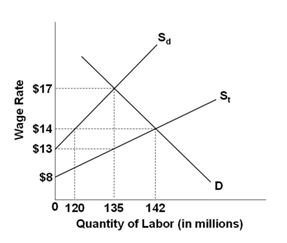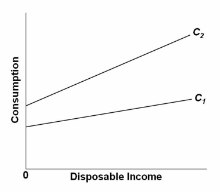Given the scenario described, if the market price of hammers increased from $9 to $13:
Assume there are three hardware stores, each willing to sell one standard model hammer in a given time period. House Depot can offer their hammer for a minimum of $7. Lace Hardware can offer the hammer for a minimum of $10. Bob's Hardware store can offer the hammer at a minimum price of $13.
A. producer surplus would increase for each producer.
B. producer surplus would increase only for House Depot.
C. producer surplus would remain unchanged for Bob's Hardware.
D. producer surplus would increase by $4 for Lace Hardware.
C. producer surplus would remain unchanged for Bob's Hardware.
You might also like to view...
Refer to the below graph of the market for low-skilled labor. Sd is the supply of domestic resident workers, and St is the total supply of labor including undocumented workers. What is the equilibrium wage rate and equilibrium employment if there is illegal immigration?

A. $14 and 142M, respectively
B. $13 and 135M, respectively
C. $14 and 120M, respectively
D. $17 and 135M, respectively
Loss aversion is the tendency to experience losses as:
A. more painful than the pleasures that result from gains of the same magnitude. B. more painful than gains of any magnitude. C. less painful than the pleasures that result from gains of the same magnitude. D. just as painful as the pleasures that result from gains of the same magnitude.
Common property
A) is owned by everyone. B) is owned by no one. C) Neither A nor B are correct. D) Both A and B are correct.
Refer to the given diagram. Suppose an economy's consumption schedule shifts from C 1 to C 2 as shown in the diagram. We can say that its:

A. MPC has increased, but its APC at each income level is unchanged.
B. APC at each income level is increased, but its MPC is unchanged.
C. MPC and APC at each income level have both increased.
D. MPC and APC at each income level have both decreased.